In this roundup, we’ll look at the Korg and Olympus units, as well as the latest incarnations of two of the most popular devices in this category—Zoom’s feature-rich H4N and Boss’ smartly designed Micro BR, and home-recording pioneers Tascam''s classic-looking DP-004
While much of the buzz in the mobile recording market of late has revolved around iPhones and iPads [see our cover story, March 2012], portable stand-alone multitrack devices have quietly gotten better and better, while offering a more stable and arguably higher-performance platform than their smart-phone counterparts. What’s more, the field is awesomely varied: Some devices, like the Korg SOS, combine multitracking with onboard effects and jamming tools, while others, like the Olympus LS-100, add multitrack options to their solid footing as pro field recorders.
In this roundup, we’ll look at the Korg and Olympus units, as well as the latest incarnations of two of the most popular devices in this category—Zoom’s feature-rich H4N and Boss’ smartly designed Micro BR, both of which boast amp and pedal models, as well as worthy master effects. Finally, we’ll catch up with home-recording pioneers Tascam, and their simple, classic-looking DP-004. In every case, you’ll encounter advantages that these dedicated units have over iPhone or iPad setups, including vastly longer battery life, quality built-in microphones, better output levels, independent level controls, slick ergonomics, USB ports for connection to a computer, up to 24-bit/96kHz audio, and expandable storage capacities by way of SD or Micro SD cards.
Just don’t expect to take a call from your mom on one of these babies.
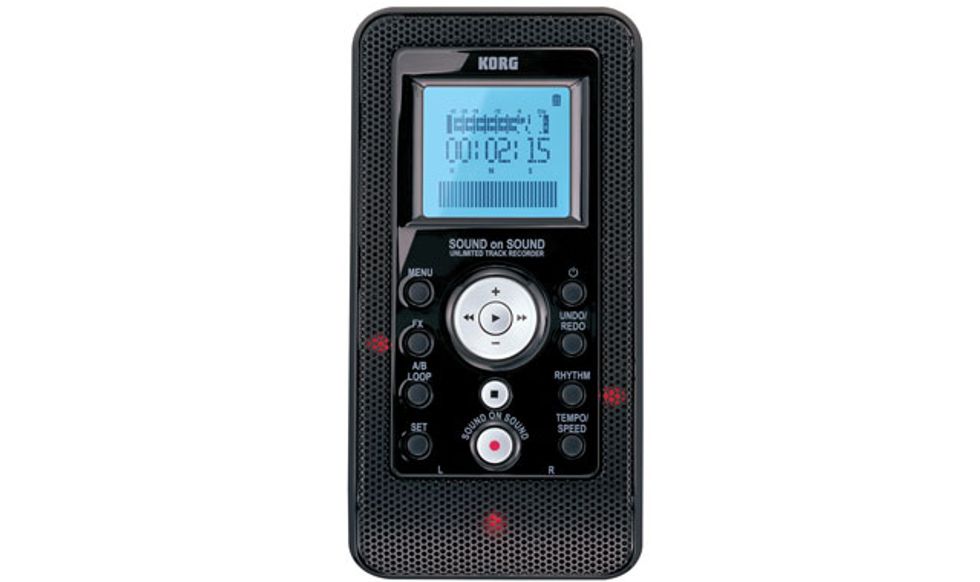
Korg SOS
• Light, truly “palm-sized” recorder with stripped-down menu set.
• “Sound On Sound” overdubbing makes for unlimited track count.
• Massive range of drum patterns and amp/effect models.
Ratings
Pros:
Clever workflow, good models, easy navigation.
Cons:
Mics are not field-recorder quality, but great for demos.
Audio Quality:
Function/Design:
Materials:
Value:
Street:
$145
Korg
korg.com
Not much bigger than a smartphone, the Korg SR-1 SOS ($145, street) combines a light, streamlined physical design with an inspired concept: Instead of the typical multitrack system, it “thinks” in terms of infinite overdubbing—the way one might approach capturing sound in a looping environment. With its ramped profile, the jet-black SOS sits on your desktop with its front panel at a slight angle toward you, like a proper mixing desk. And that front panel not only contains a 1" LED display, but also the SOS’ built-in stereo microphone and speakers, along with the main function, menu, and transport controls. Small pads on the back panel—which stores the two-AA battery compartment—keep the SOS from slipping around, while stereo mini input jacks for mic and line in, a stereo mini headphone/line out, and a ¼" jack for guitar can be found on the right side. A MicroSD card slot and 4.5V AC jack are on the left.
Much as you might use a tiny Dictaphone to capture the very first impulse of a song idea, you can use the SOS’s built-in mic to capture that vocal idea in stereo with a quality reverb, and then throw down some quick harmony ideas. No worries if you screw up—the easy undo function will wipe out as many past clunkers as you choose from the arrangement. Using one of the 200 drum tracks as a tempo guide, you can also record guitar with one of the SOS’s 100 amp/effect models. (While overdubbing, you can loop subsections of your song to record over, or simply overdub to the entire song.) That looping-type approach adds a certain casual feel to the SOS, so you may surprise yourself with adventurous, off-the-cuff stuff that you’d be unlikely to try in a stiffer recording environment—and that’s good. For such a simple device, the SOS does have something of a learning curve (lots of menus to master), but once you get the hang of it, the SOS genuinely cuts the lag time between inspiration and execution.
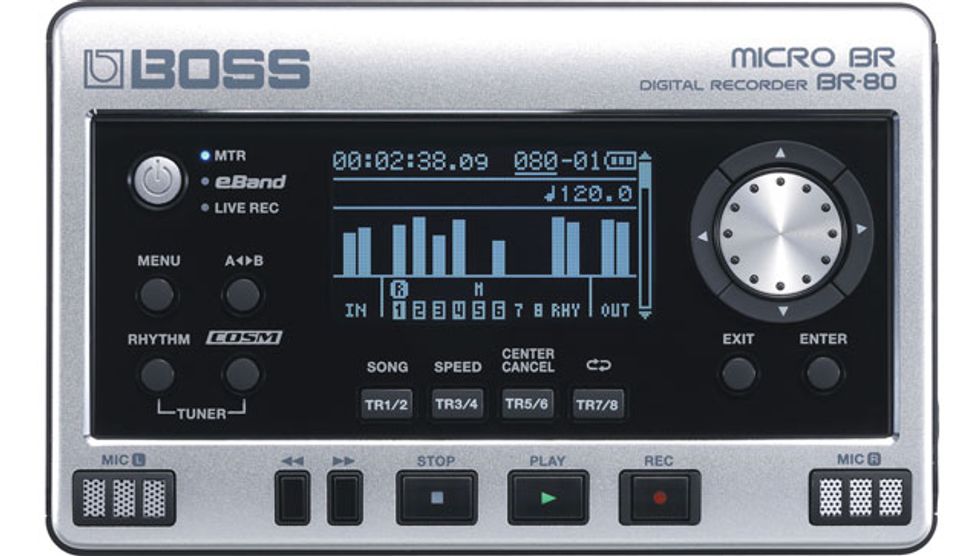
Boss Micro BR-80
• MIDI drum pattern construction kits for creating arrangements.
• Excellent amp models and effects arranged by genre and instrument.
• Eight tracks of audio, plus up to 64 “V-Tracks” for additional takes.
Ratings
Pros:
Wealth of great amps/FX/rhythms, high track count.
Cons:
Lightweight design, should come with protective case.
Audio Quality:
Function/Design:
Materials:
Value:
Street:
$159
Boss
bossus.com
When Boss first unveiled the Micro BR in 2007, it was the kind of device that everyone wanted to get their hands on—a sleek, sexy, and incredibly portable hand-held 4-track recorder with effects and amp models, easy-to-arrange drum machine patterns, and an MP3 player, all in a footprint not much bigger than a guitar tuner. Last summer, Roland introduced the first top-down update of the BR, with the decidedly modernized BR-80 ($299, street), which adds a built-in split stereo mic, 8-track recording, more and better-organized effects and models, and the new eBand mode, which makes the BR-80 a handy practice tool for jamming with MP3s while having control over playback pitch and tempo. And just for the record, it’s still one sexy looking machine.
The new stereo pair of built-in mics makes the BR a worthy all-in-one field recorder, though certainly not quite to the specs of dedicated field units like the LS-100. It’s in multitrack mode (MTR) that the BR-80 really shines. With eight full tracks to play with (plus track-bouncing options and eight virtual tracks per channel), along with independent pan, level, 3-band EQ, reverb, and solo/mute for every channel, it’s unusually broad and deep for something its size. The effects and models are solid sounding, and they’re logically laid out into preset groups by both genre and instrument. I especially dug the Surf, Fuzz Rock, Liverpool, and Progressive patches. Given the BR’s practical uses, Boss has made some smart choices here, too. It was pleasantly surprising to find pitch correction and harmonization among the vocal effects, a slew of decent mastering effects, plus simulators for making your electric guitar sound like a bass or acoustic guitar. Now that’s a real-world, recording-on-the-go stroke of genius.
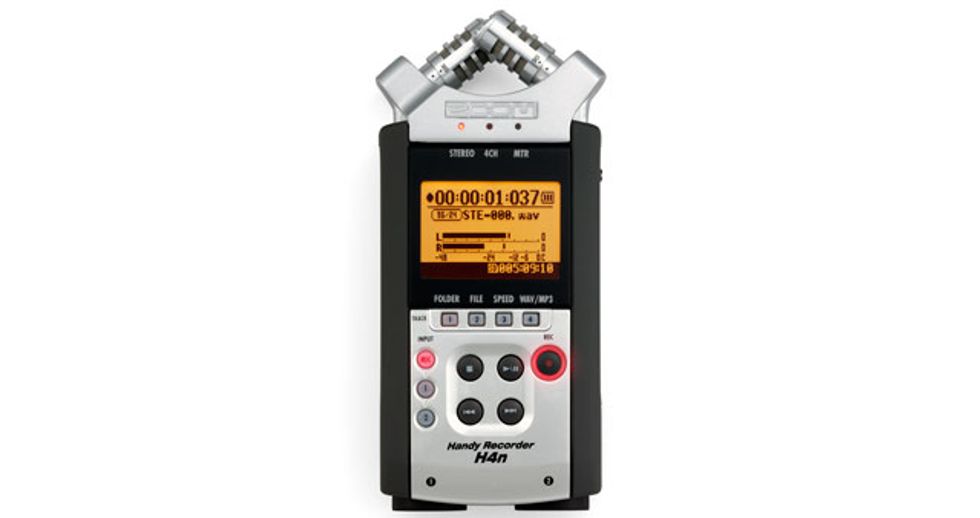
Zoom H4N
• Rugged, shock-resistant build, XLR inputs, and high-quality stereo mics.
• Bright, readable LED display and easy learning curve.
• Four-Track mode with bounce capabilities and onboard effects.
Ratings
Pros:
Serious mics and a tough build, solid 4-track.
Cons:
Dated guitar models and vocal/studio effects.
Audio Quality:
Function/Design:
Materials:
Value:
Street:
$299
Zoom
samsontech.com
By most accounts, the Zoom H4 stereo and 4-track recorder was a serious slam-dunk when it was released in 2006, and the updated H4N ($299, street) trades on its predecessor’s savvy design while adding some cool extra features—a built-in mono speaker, a bigger, more readable display, a “stamina” mode to extend battery life while stereo recording, and an XY 90/120-degree built-in mic arrangement that Zoom argues makes for better center source intelligibility, a wide stereo field, and reduced phase issues. What’s more, the audio specs have improved with the H4N’s digitally controlled preamp. In addition to stereo and 4-track modes, the H4N now adds a “4CH” mode that allows for simultaneous recording of two separate stereo pairs—use the built-in mics for one pair, and the two phantom-equipped XLR/phone jacks for the other, and then mix the signals in surround or dual stereo.
The mics themselves are a clear step up from the H4, and the rubberized, shock-resistant build is heavier and tougher. The H4N compares well to a proper field recorder and its stereo imaging is excellent, on par with many more expensive devices. The H4N is even easier to use than its predecessor, with a scrolling and menu system that becomes second nature after a few hours (though you might want to do some deep-breathing exercises for those first few hours).
One place where the H4N clearly hasn’t grown up, though, is in its amp models and effects, which haven’t changed a lick since 2006. Those models were never earth-shattering to begin with, frankly, and it’s hard to understand how a major upgrade to this product would have overlooked such a significant part of the unit’s appeal. Here’s hoping the next H4 features a major overhaul of the guitar and effect presets, with vastly improved sonics, patch organization, and far more options. A more inspired rhythm brain would be a nice touch, too.
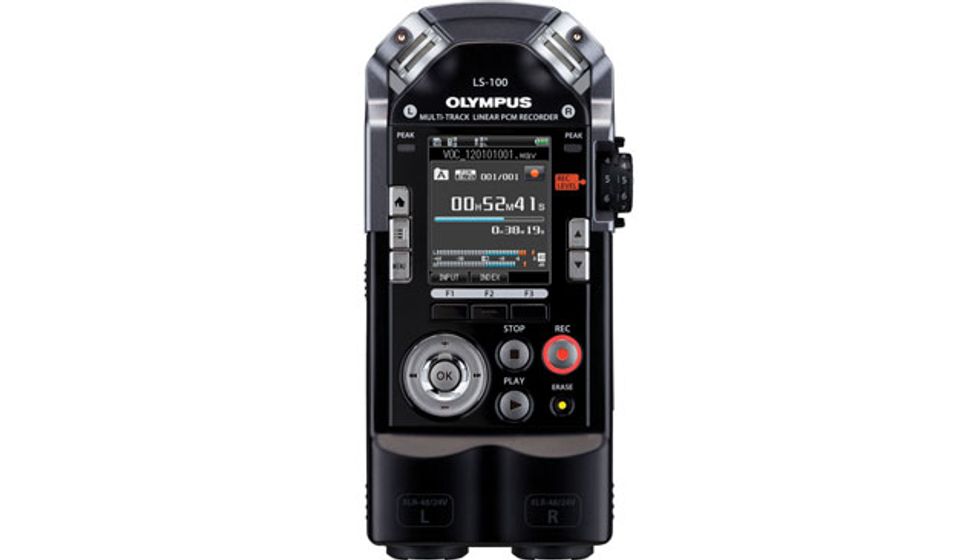
Olympus LS-100
• 24-bit/96 kHz recording; handles SPL levels up to 140 dB.
• Built-in tuner, metronome, and Lissajous phase-correction mode.
• 8-track recorder with bounce capabilities of up to 999 tracks.
Ratings
Pros:
Solid, pro mics and rugged build.
Cons:
Metronome not available in record mode.
Audio Quality:
Function/Design:
Materials:
Value:
Street:
$399
Olympus
olympusamerica.com
The LS-100 ($399, street) is an elegant 96 kHz/24-bit PCM-based machine that simply screams “professional field recorder.” But it also offers the flexibility of a multitrack machine, with up to eight independent tracks (or four stereo pairs), with bounce-down capabilities to up to 999 tracks. It features two XLR/phone combo jacks, and its top-quality stereo condenser microphones boast a frequency range of 20 Hz-20 kHz, while handling up to a whopping 140 dB. They can also be used as a USB microphone with your computer DAW.
The LS-100 is certainly a pro-grade recorder, but its multitrack mode is decidedly no-frills: no effects, no rhythm tracks, and no amp models (there is a built-in compressor/limiter for the main recorder function). The LS-100 clearly believes that it’s more important to capture quality recordings of real sounds, and add studio polish later, rather than doing a half-ass job of simulating studio effects and amps in order to make second-tier “sketch pad” demos.
That’s admirable, but Olympus’ inexperience in making multitrack machines is evident in the LS-100, despite its being touted as a “musician’s toolbox” for its metronome and tuner functions. For starters, why can’t we record using the built-in mics and two external XLR mics simultaneously, given that the connections are available to do it? What’s more, even after 30 minutes of consulting the very poorly written and hard-to-read user’s manual, I could not find a way to use the built-in metronome during stereo or multitrack recording. Really? This is a fairly unforgivable oversight, but just as frustrating was the fact that overdubbing onto separate tracks requires four button presses: one to select the track, another to enter standby, yet another to press play, and a fourth to press Record again. Why can’t I just arm the track and go, while still hearing my previous tracks? And sure, there are panning and level controls, if no EQ or reverb, but again, they require using the edge of your thumbnail to scroll through more mini-menus and press several more small directional tabs. Look, there’s nothing wrong with the superb sound quality of the LS-100. It’s just the workflow that’s artistically challenged.
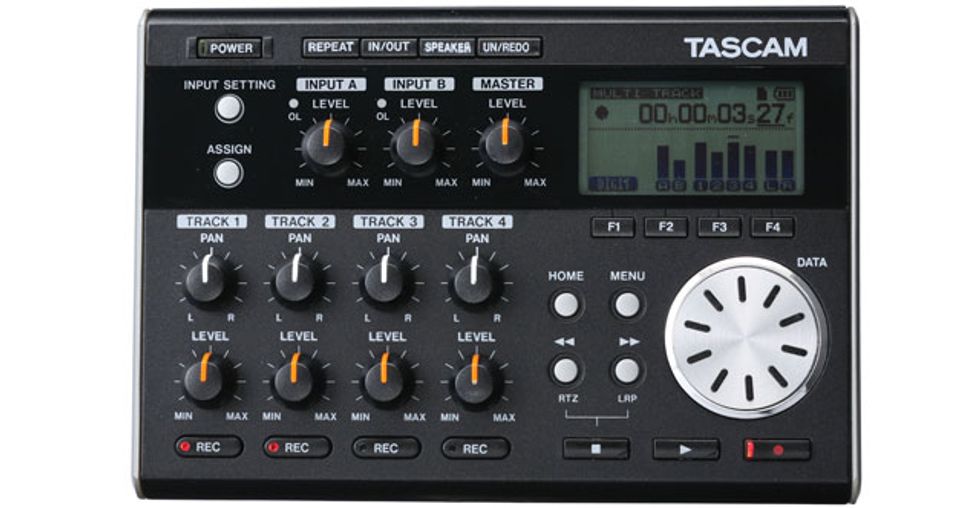
Tascam DP-004
• Front panel knobs for level, pan, and record arm controls.
• Quality built-in stereo condenser mics.
• 4-track recording with awesomely classic design.
Ratings
Pros:
No-frills, simple workflow in a classic design with built in mics.
Cons:
No bells and whistles like amp models and rhythms.
Audio Quality:
Function/Design:
Materials:
Value:
Street:
$149
Tascam
tascam.com
The Tascam DP-004 ($149, street) is a straightforward digital 4-track machine without a lot of bells and whistles, and that’s its strength. First of all, the input and output level knobs, record “arm” buttons, and the pan knobs are right there on the front housing—no scrolling through tiny LCD menus or using “multi-function” buttons on this baby. (Yes, I said “knobs”—actual physical knobs.) This old-school approach still makes a ton of sense, frankly, as does the inclusion of front-panel transport buttons for RTZ (Return to Zero) and LRP (Last Recording Position). These are all very sensible controls for a songwriter to have in easy reach.
The DP-004 has no reverb or other effects, and no amp models or “jamming buddy” modes, so it’s not pretending to be the ideal guitar-on-the-go partner. But it’s a smart, simple and good-sounding little 4-track machine (for less than 150 bucks!) with an intuitive design, a streamlined workflow, line/guitar inputs, and an excellent built-in stereo condenser mic that’s optimized by a range of input sensitivity presets for recording a band, guitar, or vocals. It records in CD-quality 16-bit, 44.1 kHz audio, and allows you to bounce multiple tracks to a single track, even if that track is part of your bounce group. Tascam has been making 4-track machines since 1979, and it shows. It’s great to see that they still know how to focus on what they do best.

